|
|
|
| My Favourite Planet > English > Europe > Greece > Thrace > Alexandroupoli |
| Alexandroupoli, Greece |
Sightseeing in Alexandroupoli |
|
 |
page 5 |
 |
|
| |

Basileos Alexandrou Street, Alexandroupoli's seafront promenade, and its landmark lighthouse. |
| |
|
| |
For many years Thrace had the reputation of being heavily militarized as a border bulwark against Turkey and Communist Bulgaria, with many areas out of bounds for visitors. Since Bulgaria has become a member of the European Union and sabre-rattling between Greece and Turkey has become a less popular sport, the area has gradually opened up.
From the 1990s there were massive investments in the region by Greece and the European Union aimed at making the region more accessible and attractive to businesses and tourists, including improvements in infrastucture and transport by road, rail, air and sea.
Much of these efforts have recently been negated by the Greek economic crisis which has hit the region hard, particularly with the closure of international rail connections via Bulgaria and Turkey, and the cancellation of ferry services to islands. Once again this isolated area on the edge of Europe has become more difficult to reach for visitors.
As with the other coastal areas of Macedonia and Thrace, the majority of holidaymakers come from Russia, Bulgaria and other Balkan countries, along with a number of interpid Germans, seeking a seaside vacation in a more relaxed, less crowded environment.
So, a large area of land, with plenty of beaches and many places of outstanding natural beauty, fascinating towns and villages with a mix of ethnic cultures and architectural styles, several churches, monasteries and mosques, as well as some small museums and modest historical sites. And hardly any tourists. Not great for the local economy but wonderful for the more adventurous traveller.
The main assets of the area are the friendliness and culture of the people who live here, and the countryside in which they live. |
|
 |
| |

The symbol of
East Macedonia
and Thrace |
| |
If you would like your museum or tourist attraction
to be featured in this guide, please get in contact. |
Alexandroupoli
sightseeing |
Sights in Alexandroupoli |
|
 |
|
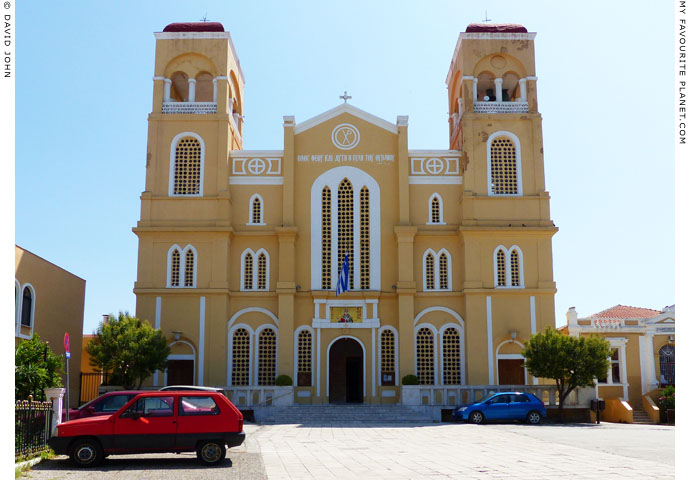
The cathedral church of Agios Nicholaos, Alexandroupoli.
|
Most of the buildings in Alexandroupoli are modern concrete blocks, although there are a few older buildings from the time of the city's foundation in the late 19th to early 20th centuries. The streets are generally long and narrow, with some open spaces at squares and small parks.
As you would expect, Alexandroupoli has many Greek Orthodox churches and a cathedral. However, it also has an Armenian Orthodox church, a small mosque and the Roman Catholic church of Saint Joseph.
The most interesting area is the seafront, west of the port: the trademark lighthouse stands on the main promenade where locals make their early evening volta (stroll) before dinner. Here also are several restaurants and bars.
The Lighthouse of Alexandroupolis
(Ο φάρος της Αλεξανδρούπολης, O Faros tis Alexandroupolis)
The lighthouse on Odos Vasileos Alexandrou, on the west side of the port, is the symbolic landmark of the city. Built by a French company in 1880, it is 17 metres tall, its top is 27 metres above sea level and its beam is said to be visible for 44 km.
A fountain and pool have recently been added to the front of the lighthouse facing the sea. The lighthouse and fountain are illuminated at night, and this is a popular meeting place for young people on summer evenings (see the photo on page 1 of this guide).
The New "Nomarcheio"
(Το νέο «Νομαρχείο» Έβρου)
Just to the west of the Lighthouse along Odos Basileos Alexandrou (King Alexander Street), Alexandroupoli's seafront promenade, are a number of grand public buildings, including the New "Nomarcheio", the courthouse and the post office.
The New "Nomarcheio" is a modern building in the neoclassical style, opened in 2014 as a venue for meetings and cultural events with an art gallery exhibiting works by local artists.
The new building replaces the old nomarcheio, completed in 1905 as the Greek consulate at the time when the area was still part of the Ottoman Empire. It was donated to the Greek state by Dr Alexandros Kriti (Αλεξάνδρος Κρήτη), and after West Thrace became part of modern Greece in 1920 it was made the administrative centre (nomarcheio) of the old prefecture (nomos) of Evros. Following the national reforms of administrative regions (2006-2011) the building was no longer in use, and was eventually demolished.
Although the new building still bears the name "Nomarcheio", the administrative business of the Evros regional unit now continues in another building nearby.
Cathedral of Agios Nikolaos
(Μητροπολιτικός Ναός Αγίου Νικολάου)
The Metropolitan Cathedral of Agios Nikolaos (Άγιος Νικόλαος, Saint Nicholas) is in the city centre. Construction began in 1898 and it was inaugurated in 1901. Built by architects and craftsmen from Constantinople (today Istanbul), the design of the cathedral is said to be based on that of the Hagia Triada (Holy Trinity) church in Taksim, Istanbul (built 1880).
Like many Orthodox churches, it has a miracle-working relic, in this case a 13th century icon of the Panagia Trifotissa (Παναγια Τριφωτισσα) from Aenos (now Enez, Turkey) on the east side of the Evros River. It is claimed that praying before the icon cures people with eye diseases.
Agios Nikolaos is the patron saint of Alexandroupoli, and in Greece he is considered the protector of sailors and fishermen. The first church in Alexandroupoli (then known as Dedeagach) was built in 1850 by local fisherman and also dedicated to Agios Nikolaos.
Plateia Metropoleos (Πλατεία Μητροπόλεως),
68100 Alexandroupoli.
(Also referred to as Plateia Agiou Nikolaou)
From Leoforos Dimokratia, walk north
along Leoforos 14th Maiou for 2 blocks.
Then turn right at Konstantinou Paleologou Street.
The cathedral and Ecclesiastical Art Museum (see below) are on the large square Plateia Agiou Nikolaou after 1 block.
5 minutes walk from the ferry port.
Opening hours:
Like most churches in Greece, it is open mornings until
12 noon, some evenings and during religious services. |
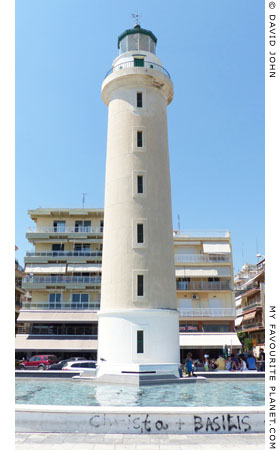
Alexandroupolis Lighthouse |
| |
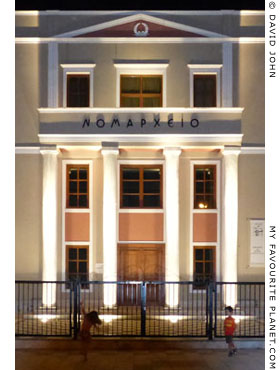
The grand neoclassical entrance
of the New "Nomarcheio" |
| |
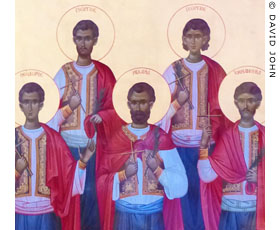
Detail of an icon depicting the Five
Martyrs of Samothraki in the Cathedral. |
| |
| |
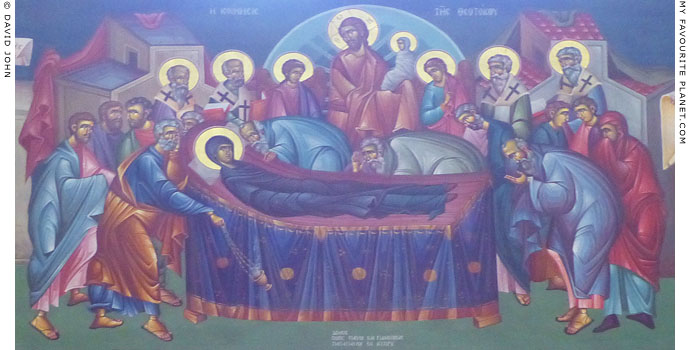
Detail of a large icon in the Cathedral of Alexandroupoli depicting the death of the Virgin Mary.
|
The "Kimisis Tis Theotokou" (Η Κοίμηση της Θεοτόκου, or Κοίμησις Θεοτόκου), literally the "falling-asleep" (or Dormition) "of the mother of God", the death of the Virgin Mary (in Greek Παναγία, Panagia, "all holy"), known to Roman Catholics as the Assumption of the Virgin Mary, has become one of the most important religious festivals of the Greek Orthodox Church.
Celebrated by Greeks on 15th August, it is almost as important as Easter and celebrated with more ceremony, public participation and enthusiasm than Christmas. It is popularly known as "the Easter of summer" (Πάσχα του καλοκαιριού, Paska tou Kalokairiou), and apart from the various religious services, rituals and processions celebrated by the faithful throughout Greece, Cyprus and the diaspora, Greeks also celebrate with large public parties in town and village squares, with much eating, drinking, traditional music and dancing.
Often the parties go on all night or even over a couple of days. Many Greeks living in cities return to their home or ancestoral villages to celebrate the "Panegyri" (πανήγυρις, gathering) with family and friends. See a photo of a 15th August Panegyri in Orestiada, northeastern Thrace. In some places there is a distinctly profane carnival atmosphere with fairground attractions and stalls selling toys and tawdries.
What is being celebrated is not the Virgin Mary's physical death, but her assumption; her transcendance from the physical to the heavenly, spiritual world, at the very top of the celestial hierarchy next to Christ and God, from where she intercedes on behalf of faithful mortals.
Many Greek Orthodox churches are dedicated to the Kimisis Tis Theotokou, for example in Kavala and Kokkari, Samos. According to church tradition, Mary left the mortal realm in Jerusalem, and in icons of the event she is shown surrounded by 11 of the 12 disciples (somehow all gathered together; Judas had already departed life by quite another route), a female figure (veiled in red, on the right of the photo; Mary Magdalene?) and two angels (presumably Archangels Michael and Gabriel), and in this painting four other later saints, church fathers or evangelists are also in attendance. At the edges of the icon (not shown in the photo above for reasons of space) four more saints hold scrolls recording the events. In the centre Christ receives Mary's soul in the form of a small swaddled figure. |
|
|
| |
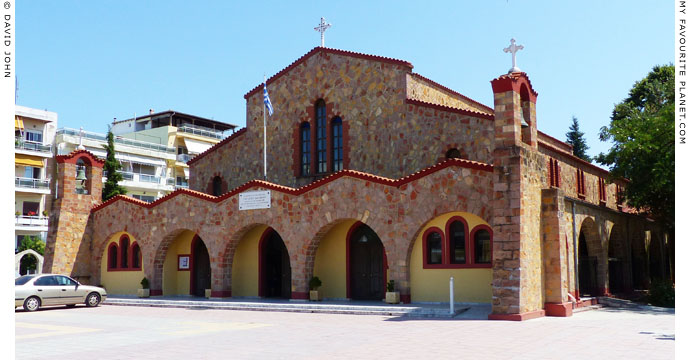
Agios Eleftherios church, Alexandroupoli.
|
Church of Agios Eleftherios
(Ιερος Ναός Αγίου Ελευθερίου)
Designed in the form of a basilica, the stone-built church was inaugurated in 1955, and replaced a wooden church which stood nearby.
According to some sources it seems that the earlier church was used by the Bulgarian community in Alexandroupoli before World War II and was dedicated to Saint Slobodan.
Like the cathedral, the present church stands in a large, open square.
Odos Ipsilantou, Alexandroupoli.
One block east of the Cathedral,
along Odos Elenis Filppidou. |
|
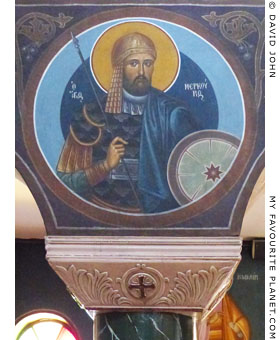
One of the icons above each column
along either side of the nave of
Agios Eleftherios Church, each depicting
a warrior saint. This is Saint Mercurius
(Άγιος Μερκούριος, Agios Mekourios),
a 3rd century Roman soldier
and Christian martyr. |
|
| |

The elegant interior of Agios Eleftherios church, Alexandroupoli.
|
Armenian Orthodox Church
The small, simple Armenian Orthodox church of Saint John the Baptist (known in Armenian as Surb Karapet, the Holy Forerunner) is the oldest church in Alexandroupoli, and the water fountain in its coutyard the oldest in the city.
Armenians arrived here in the 1870s to work on the new port and railway at the time when the town was growing from a village, then known by its Turkish name Dedeagach (Dedeağaç; Greek, Δεδεαγάτς). The local Armenian congegration was founded in 1875 and the construction of the church was completed in 1886.
The church is still used by the local Armenian community which also runs a school.
The Armenians claim to be the first nation to have accepted Christianity, and their deeply-rooted Christian traditions and attitudes have survived centuries of foreign domination, first by the Ottoman Turks, and latterly also by the Soviet Union. Their churches are usually markedly simpler, humbler than those of other Christian denominations, particularly the Eastern Orthodox. There is no grand iconistasis or other paraphenalia filling the interior or exterior space. Where art is used to illustrate religious themes (mostly paintings), it is usually less extravagant and more sparing, sombre and restrained in style.
Anatolikis Thrakis 54, 68100 Alexandroupoli.
Near the northwest corner of Leoforos 14th Maiou,
just north of the Ethnological Museum (see below).
Tel: +30 25510 36683
The church is not usually open to the public, but it is possible to enter the courtyard which has the water fountain and a khachkar, a commemorative stone cross, brought from Armenia in 2009.
There are also Armenian churches in Athens, Thessaloniki,
Kavala, Komotini, Xanthi and Didymoteicho. |
|
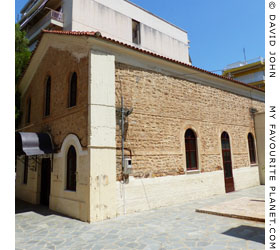
Alexandroupoli's small Armenian Church,
in its own courtyard, surrounded by
modern apartment blocks.
See also the photo below. |
|
| |
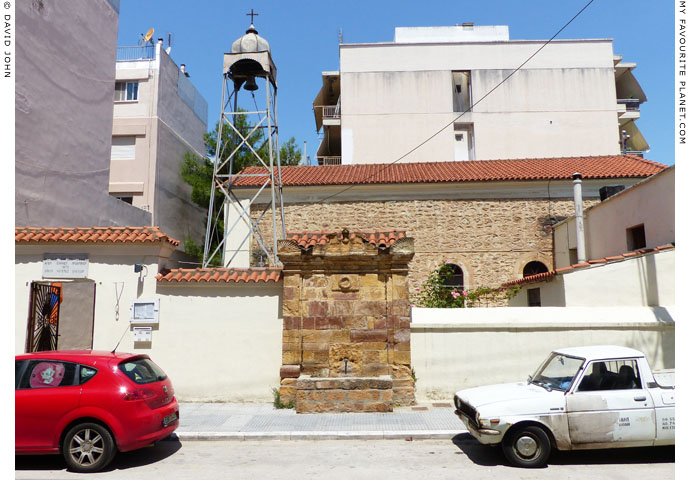
The Armenian church of Surb Karapet, from the narrow street
Odos Anatolikis Thrakis. The water fountain, built into the wall
enclosing the churchyard, is said to have been the first in the city.
|
Saint Joseph's Roman Catholic Church
Saint Joseph's is the only Roman Catholic church in Thrace. Like the Greek Orthodox Church of Agios Eleftherios (see above), it was designed as a stone basilica. Completed in 1901, it served as the parish church for the local Roman Catholic community, mostly employees of western consulates and firms. The church was looted and badly damaged during the Bulgarian occupation of the city. It was renovated after World War II, and again in 2006.
Due to the dwindling number of Catholics and lack of priests it came under the auspices of the Apostolic Vicariate of Thessaloniki, and since 1981 it has been run by the Roman Catholic order of Lazarists who also have a monastery in Kavala. Masses and cultural events of a religious nature are occasionally held here.
Odos Eleftheriou Venizelou 76, 68100 Alexandroupoli.
On the corner of Odos Komninon.
About 200 metres north of the post office.
Tel: +30 25510 81455
The Mosque of Alexandroupoli
According to a plaque above its door, the mosque was opened in 1906. It has a square plan, elaborate marble decoration and inscriptions, the marble tomb of Fayek Hussein Pasha, an important Ottoman general, and a minaret on its west side.
It was destroyed by arson twice during the 20th century, most recently in 1993, and each time the Greek government financed its rebuilding.
The mosque is still used regularly by the local Muslim community, which also has a Muslim primary school. Its grounds originally included a medressa (Islamic school), but it now stands in a small area surrounded by houses, which makes it difficult to find.
Like the Roman Catholic and Armenian churches, it is not highlighted on the offical tourist maps of the city. This may be partly due to security considerations, as the mosque has been subject to attacks by right wing nationalist fanatics, the most recent outrage occurred in 2014.
Odos Kassandras 1, 68100 Alexandroupoli.
The entrance to the mosque is in the north part of Odos Kassandras, a narrow pedestrianized alleyway between Leoforos Dimokratias and Odos Emporiou; east of Odos Filippoupoleos and west of Odos Souniou.
It is around 200 metres south of Agios Eleftherios Church.
There are several other working mosques around Macedonia and Thrace, notably in Xanthi and Komotini. Other historic mosques include the Halil Bey Mosque, Kavala (where there is also a renovated imaret) and the large Çelebi Sultan Mehmed Mosque in Didymoteicho, the first Ottoman mosque built in Europe. |
|
|
|
| |
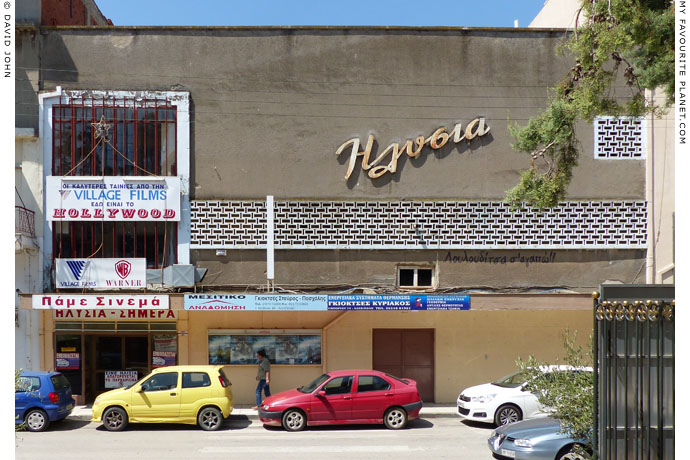
The Ilysia (Ηλύσια) Cinema, opposite the Cathedral.
Unfortunately, the cinema closed down in July 2014.
|
The original building of the cinema was a former publicly-owned tobacco warehouse granted to the Association of Women and Girls Alexandroupolis between 1925 and 1927 and rented to an Armenian tobacco merchant. Between 1927 and 1930 it was converted to a cinema, before the being replaced by the present, purpose-built 400-seat movie theatre in 1968. Over recent years, as at many other cinemas worldwide, audiences have dwindled due the growing popularity of TV, videos, DVDs and computer entertainment. And finally the Greek economic crisis has done the rest.
Cinema fans will be glad to hear that the municipal open-air cinema Flisvos (Φλοίσβος) is still showing films in the summer months (June-September). The entrance is next to the Municipal Campsite (see page 3: Practical information) and opposite the EOT beach, 2 km west of the city centre.
Other cinemas in Alexandroupoli:
Leski (Λέσχη), Odos Eleftheriou Venizelou 17. Τel: 25510 31720
Alex (Άλεξ), Odos Konstantinos Palaiologou 18. Τel: 25510 24110 |
|
|
| |
Alexandroupoli
sightseeing |
Museums in and around
Alexandroupoli |
|
 |
|
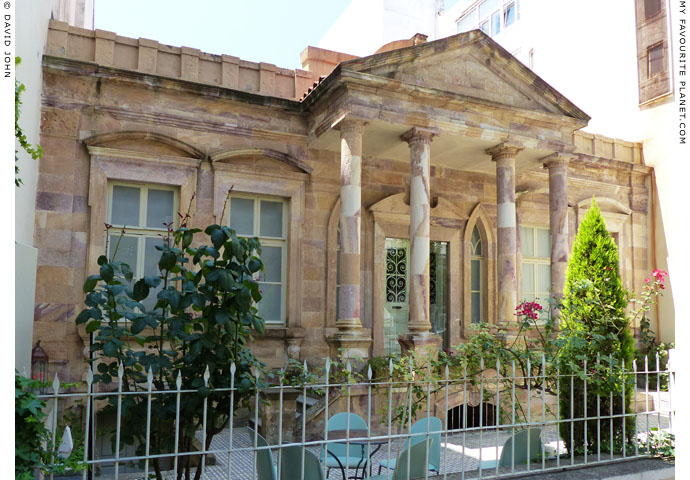
The neoclassical facade of the Ethnological Museum of Thrace,
set back from the street with its own front garden.
|
Ethnological Museum of Thrace
(Εθνολογικό Μουσείο Θράκης)
The private museum is housed in a handsome neoclassical mansion in the city centre, built in 1899 as the country residence of a certain Altinalmazis, a businessman from Edirne.
Exhibits include traditional costumes, textiles, musical instruments, ceramics and copperware, as well as historic tools and equipment used in agriculture and the local production of wine, silk, dyes, oil, tobacco, honey and sweets.
The museum is worth visiting just to see the house itself, and 30-40 minutes to admire the well-designed displays of excellent costumes and objects offering insights into the work, trades, faith, domestic routine and special events in the lives of local people, particularly from the 18th to the 20th centuries. The rooms are organized thematically, and there are information boards with old photos and clear texts in Greek and English describing historical and social contexts.
There is a shop with a selection of books, postcards and handmade local craft objects. An excellent, richly-illustrated book about the museum and its exhibits, with texts in Greek and English, is available for €20. There is also a cafe in the shaded garden at the rear of the museum.
We were very impressed by the quality of the exhibits, the clarity of accompanying information and the aesthetics of the exhibition and the museum as a whole. The staff are helpful and friendly and the shop and cafe are very inviting. The museum is a labour of love and the product of patient collecting and conservation, deep local knowledge and careful and intelligent planning and design of its founder and director Angeliki Giannakidou.
Leoforos 14th Maiou 63, 68100 Alexandroupoli.
On the left (west) side of the street,
6 blocks north of Leoforos Dimokratias.
10 minutes walk from the ferry port.
5 minutes walk from the KTEL inter-city bus station.
Tel/Fax: (+30) 2551 036 663
Website: www.emthrace.org (Greek, English, Russian)
Opening hours:
March to September
Tuesday, Wednesday 9:00-15:00;
Thursday, Friday 9:00-15:00 and 18:00-21:00;
Saturday, Sunday 10:00-15:00
October to February
Tuesday - Saturday 9:00-15.00; Sunday 10:00 - 15:00
Closed Mondays (like most museums in Greece)
Admission: adults 3 Euros; children free
Those interested in the history, traditions and life in Macedonia and Thrace may also like to visit the Folklife and Ethnological Museum Macedonia and Thrace (Λαογραφικό και Εθνολογικό Μουσείο Μακεδονίας - Θράκης) in Thessaloniki.
See: www.lemmth.gr (Greek and English)
See also the Roma Basketry Museum
(Μουσείο Καλαθοπλεκτικής των Ρωμά)
in Thrilori, 9 km outside Komotini (65 km northwest
of Alexandroupoli):
romagr.gr/museum/
(in Greek, English, Bulgarian and Turkish) |
|
| |
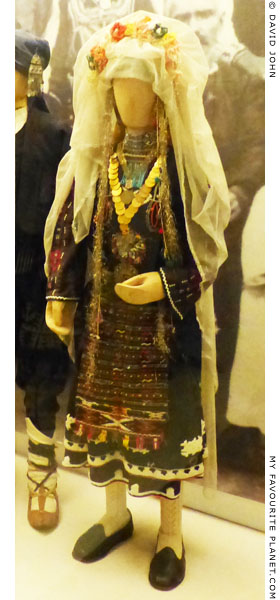
One of the traditional costumes
in the Ethnological Museum of Thrace:
a bridal costume of the Mari clan. |
| |
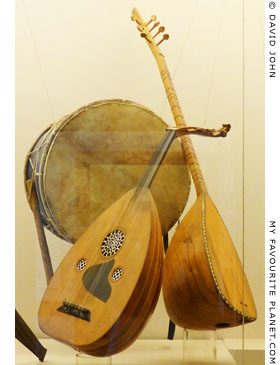
Traditional musical instruments
in the Ethnological Museum of Thrace. |
| |
| |
Ecclesiastical Art Museum
of Alexandroupoli
(Εκκλησιαστικό Μουσείο Αλεξανδρούπολης)
The museum, next to the cathedral (see above), is run by the Metropolis (bishopric) of Alexandroupoli. It is housed in a handsome neoclassical building, a listed monument built in 1909, which was the Leontarideios School for Boys until 1972.
The collection of over 400 religious objects includes icons and relics dating from the 15th-19th centuries and early printed Greek books, saved from churches and monasteries of the region, including parts of Thrace which are now part of Turkey and Bulgaria. Many of the objects were bought to West Thrace by Greek refugees from Turkey during the 1920s.
Plateia Metropoleos (Πλατεία Μητροπόλεως),
also known as as Plateia Agiou Nikolaou,
68100 Alexandroupoli.
From Leoforos Dimokratia, walk north along
Leoforos 14th Maiou for 2 blocks.
Then turn right at Konstantinou Paleologou Street.
The cathedral and museum are on a large square,
Plateia Agiou Nikolaou after 1 block.
5 minutes walk from the ferry port.
Tel: +30 25510 26359
Opening hours:
Tuesday - Friday 9:00-14:00;
Saturday 10:00-14:00.
Monday closed.
Admission: adults 3 Euros; children free
|
|
| |
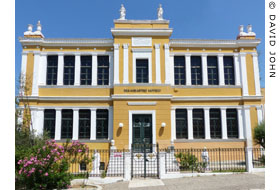
The Ecclesiastical Art Museum
of Alexandroupoli |
| |
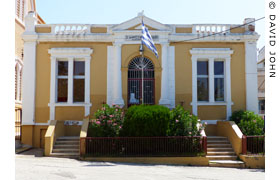
The 3rd Demotiko School of
Alexandroupoli, the old primary school,
built 1909, on Metropoleos Square,
next to the Cathedral and opposite
the Ecclesiastical Art Museum. |
|
Alexandroupolis Historical Museum
(Ιστορικό Μουσείο Αλεξανδρούπολης)
The museum has a permanent exhibition of the history of Alexandroupoli and the surrounding area, including local archaeological sites. Themes include the creation and development of the city, particularly in relation to the railway and port, local architecture, politics, economy, social and intellectual life and ethnic groups.
Leoforos Dimokratias 335, 68100 Alexandroupoli.
Opposite the Town Hall.
Tel: +30 25510 28 926
www.ismo.gr (in Greek only)
Opening hours:
Tuesday - Saturday 10:30 - 14:30.
Sunday and Monday closed.
Admission: 2 € . Soldiers, students and children 1 €.
|
|
|
Natural History Museum
of Alexandroupoli
(Μουσείο Φυσικής Ιστορίας Αλεξανδρούπολης)
A modern building among plane trees in the village of Maistros (Μαΐστρος), 2 km east of the city centre.
The aim of the museum is to educate and inform the public about the natural environment of Thrace, with themed sections on ecosystems, biodiversity and man and the environment.
Exhibits include a few stuffed birds, small animal skeletons and seashells. The main focus of the exhibitions is on multimedia displays and large printed information boards showing maps, graphics and photos.
Maistros can be reached from the city centre by local bus number 2. Fare 1.10 €.
(See How to get to Alexandroupoli: Local buses)
Platanotopos Maistrou, 68100 Alexandroupolis.
Tel: +30 25510 80204
Old website: http://mfia.alexpolis.gr/
(Greek and English; no longer updated)
New website: mfialexandroupolis.blogspot.gr
(Greek only)
Opening hours:
Tuesday - Friday 9:00 - 15:00;
Saturday - Sunday 11.00 - 14:00,
Monday closed.
Admission: no information available.
|
|
|
Flora and Fauna Museum of
the Evros Delta, Alexandroupoli
Georgios Vizyinos Art and Culture Centre, Alexandroupoli.
Tel: +30 25510 26200
There is almost no information available about this museum - not even the address - although it is mentioned by several guides and websites, including official tourist maps and brochures published by Alexandroupoli and Evros authorities. On one street map it marked at the corner of Kyprou and Dikastirion streets, one block northeast of the Lighthouse.
The museum was founded in 1985 to house local ornithologist Christos Goudner's collection of stuffed birds and animals from the Evros Delta and other local wildlife areas, as well as photographs. The most recent reliable reference to the museum is dated 2003, and one wonders if it is still running now that the Natural History Museum has been opened.
If you have any information about this museum,
please get in contact.
|
|
|
Archaeological Museum of Komotini
(Αρχαιολογικό Μουσείο Κομοτηνής)
There is no archaeological museum in or near Alexandroupoli (but see Historical Museum above).
Many of the archaeological finds from the area are in Komotini, 68 km away.
The Archaeological Museum of Komotini exhibits finds from sites in the Rhodope and Evros regional units of Thrace, including Stryme, Dikea, Abdera, Maroneia, Makri, Mesembria-Zone, Orestiada and Traianoupolis.
(See archaeological sites below.)
4 Symenonidi Street (corner of Vyronos Street),
69100 Komotini.
Komotini is 68 km northwest of Alexandroupoli.
The museum is in the south of the city centre,
350 metres northwest of the KTEL inter-city bus station
(see How to get to Alexandroupoli).
Tel: +30 25310 22411
Details:
odysseus.culture.gr/h/1/eh155.jsp?obj_id=3423
Opening hours: Daily 08:00-15:00.
Admission: 2 € |
|
|
|
| |
Alexandroupoli
sightseeing |
Alexandroupoli beaches |
|
 |
|
The municipality of Alexandroupoli has 25 km of beaches along its Aegean coast. The beaches immediately around the city centre are hardly paradisical, but they are all right for a sunbathe or a picnic while you are waiting for a bus, train, plane or ferry.
To the east of the city a long stretch of beach begins outside the port area and continues to the start of the Evros Delta (see below). This stretch attracts few bathers or holidaymakers, and a quick look at a map or satellite photo of the area will show you that the coast is hardly inhabited: nobody has built their holiday home, a hotel or taverna here. There is much talk about industrial pollution brought down the Evros river from Bulgaria, but it could also be that the general quality of the beaches and other topographical factors have so far prevented tourist development.
West of the city things look a lot brighter. A string of suburbs and villages offer facilities for beach fans and are popular with families. The good sandy beaches have shallow water ideal for children. The water is clean and some beaches have blue flag status.
2 km west is the beach near the Municipal Campsite (see page 1). At 10 km Demirali Beach at Saint George (Άη Γιώργη, Ai Georgios) is a popular sandy beach with good restaurants.
At 14 km the well-known and more touristy beach of Agia Paraskevi at Panorama (Πανόραμα), 2 km southwest of the village of Makri (Μακρή), attracts young crowds with its bars and clubs.
The EO2 National Road follows the coast to the west of Alexandroupoli, seldom more than a kilometre inland. Side roads lead to the beaches and some run along the shore for a short stretch.
If you are looking for a more secluded beach, you have to drive or pedal quite a way from the seaside settlements which, unsurprisingly, seem to expand further along the coast each year. |
|
|
| |
Alexandroupoli
sightseeing |
Sights and sites
near Alexandroupoli |
|
 |
|
|
| |
|
| |
There are many places of natural beauty and historic interest to visit around Alexandroupoli. The most fascinating and visually spectacular is the mountain island of Samothraki, compared with which the attractions of the mainland may appear very modest.
The towns and villages, inhabited by Christians and Muslims speaking Greek, Turkish and Bulgarian, feature traditional houses, churches and mosques, as well the remains of Byzantine and Ottoman fortifications (for example at Didymoteicho and Pythion). There are also Thracian tombs and the ruins of ancient cities.
For nature lovers, the mountain areas in the north of the region offer wonderful landscapes and opportunities for hiking and observing rare flora and fauna. In the immediate vicinity of the city, the wetlands of the Evros Delta National Park are definitely worth visiting.
The Evros Delta National Park
(Το Δέλτα του Έβρου)
Evros Delta Visitor Centre (Κέντρο Πληροφόρησης Δέλτα Έβρου) in Traianoupoli,
Loutra Traianoupolis (Λουτρά Τραϊανουπόλεως), 68100 Alexandroupoli.
The visitor centre is 14 km east of Alexandroupoli, on the National Road EO2.
It can be reached by local bus number 5 to Loutra (see How to get to Alexandroupoli).
Tel/Fax: +30 25510 61000
Website: www.evros-delta.gr (in Greek and English)
Opening hours:
7 days a week. From 8:30 Monday-Friday.
Maps, information, tours and permits for restricted areas.
See also information for the nearby Archaeological Site of Traianoupoli below.
The 480 km long Evros River, also known as the Maritsa (Ancient Greek, Ἕβρος, Latinized as Hebrus; Modern Greek, Έβρος, Evros; Bulgarian, Марица; Turkish, Meriç), has its source in Bulgaria from where it runs south, forming the natural boundary between Greece and Turkey. Around 30 km before it reaches the Aegean Sea it divides into two streams which form the 188 square kilometre Evros Delta.
The soil of the delta is enriched by the alluvial deposits brought here by the river, and cotton, wheat, corn and beets are grown by farmers. However the weltand area is wild in many places, and home to numerous species of plants and wild animals, particularly birds:
Over 300 plant species, 40 species of mammals, 28 species of amphibians, 46 species of fresh water fish and more than 320 bird species. There is no information about the insect population (for example bees and mosquitos), without whom many of the other species would die out.
There is open access for visitors and vehicles in the west part of the national park, but some areas, especially in the east may be visited only with a guide for national parks or an escort with a special permit. This is partly to protect the wildlife, but mainly because it is a sensitive border area controlled by the army.
Guided tours by minibus and boat are available from the visitor centre. To obtain a permit (free of charge) or arrange a tour (10 Euros), contact the centre at least 14 days in advance (e-mail address on the website).
NOTE: The centre's website is attractive but a little buggy. When you find a page with the information you are looking for it appears in Greek, but clicking on the button for English just returns you to the homepage. A simple page with basic information (e.g. centre opening times, geographical outline, visitor conditions, permits and tours, public transport) and a map would be a great improvement.
See also BirdWING (Birdwatching in Northern Greece), the website by Steve Mills and Hilary Koll:
www.birdwing.eu/sites-of-northern-greece/evros-delta (in English) |
|
|
| |
|
Alexandroupoli
sightseeing |
Archaeological sites |
|
 |
|
There is little published research about the ancient settlements and cities of this part of Thrace, and many sites have yet to be explored in depth by archaeologists. Apart from the region's remoteness, the difficulties in identifying sites are due partly to the fact that ancient authors have left us scant information about these places: none of the small cities here appear to played a sufficiently significant role in historical events to have aroused their interest.
The original tribal people of Thrace were gradually supplanted from the 8th century BC by Greek colonists who built small cities along the coast. From the 4th century BC much of ancient Thrace was conquered by the Macedonians, and then in the 2nd century BC by the Romans who built the Via Egnatia highway from what is today Albania, across northern Greece and on to Byzantium (later Constantinople, now Istanbul). Along this road new settlements also grew, and some prospered into Byzantine and Ottoman times, while other towns disappeared from the map.
None of the sites is very exciting visually, and there is often little to see apart from the foundations of a few buildings and some parts of walls. However, some of the locations are set in splendid landscapes. Around the area are also a number of ancient tombs: most are in remote locations and difficult to visit.
Archaeological sites in the Rhodope and Evros regional units of Thrace are managed by:
19th Ephorate of Prehistoric and Classical Antiquities,
4 Alexandrou Simeonidi Street, 69100 Komotini.
Tel: +30 25310 22411
Details: www.yppo.gr/1/e1540.jsp?obj_id=62
Archaeological finds from the area are in
the Archaeological Museum of Komotini (see above). |
|
|
| |
| |
East of Alexandroupoli |
 |
|
| |
Traianoupoli
The Archaeological Site of Traianoupoli (Τραϊανούπολη)
Loutra Traianoupolis (Λουτρά Τραϊανουπόλεως), 68100 Alexandroupoli.
(NOT to be confused with the modern village of Loutra, 2 km north.)
14 km east of Alexandroupoli, on the east bank of the Loutros River.
100 metres east of the Evros Delta Visitor Centre (see above).
Take the National Road EO2 eastwards from Alexandroupoli.
Turn left (north) for Traianoupoli.
There are brown "cultural route" road signs pointing the way to "Thermal Springs of Traianoupoli"
and "Traianoupoli" just before the turn-off.
Follow the side road for 300 metres and watch out for road signs for local hotels and restaurants.
It can also be reached by local bus number 5 to Loutra (see How to get to Alexandroupoli).
The city was founded on the site of a more ancient settlement around 109 AD, during the reign of Emperor Trajan (53-117 AD, reigned 98-117 AD), and named after him during the reign of his successor Hadrian. It became an important city along the Roman Via Egnatia.
The location has a thermal spring with water at a temperature of 52 degrees centigrade, and the Romans, Byzantines and Ottomans built baths here. The main attractions of the site are the ruins of these baths and the Hanna (Χάνα, also known as the Hani Evren Bey), a long building built 1370-1390 by the Turkish military commander Gazi Ahmet Evrenos as a hostel for travellers.
There is now a modern thermal bath here at a local community-run hotel. See:
tieda.gr/en/thermal-springs/hotel-of-traianoupolis |
|
|
| |
Ancient Doriskos
The archaeological site of Ancient Doriskos (Δορίσκος),
at the modern village of the same name.
22 km east of Alexandroupoli.
Take the National Road EO2 eastwards from Alexandroupoli.
1 km after the village of Monastiraki (Μοναστηράκι) turn left for Doriskos village,
3 km along a narrow country road.
At the turn-off there is a small blue road sign pointing to the village, but it is easy to miss.
There are none of the usual brown "cultural route" road signs pointing the way to the site:
ask someone in the village.
The site is not easy to find as the view from the village is obscured by houses and farm buildings.
There is really not much to see, and although several ancient objects have been discovered here, it has not yet been thoroughly excavated.
In antiquity the hilltop city was on the coast, but due to the silting of the mouth of the Evros River its ruins are now about 18 km from the sea, on the edge of the delta.
According to the Greek historian Herodotus, the Persian King Xerxes I counted his enormous army here in 480 BC, before marching westwards to Halkidiki on his campaign to conquer Greece (see History of Alexandroupoli and History of Stageira and Olympiada Part 4).
6 km further northeast along the EO2 is the village of Feres (Φέρες). 1.2 km from this village is a short, ruined section (2 arches) of a Byzantine aqueduct built around 1200 AD by Isaac Komnenos. |
|
|
| |
| |
West of Alexandroupoli |
 |
|
| |
Mesembria-Zone
The archaeological site of Mesembria-Zone
(Μεσημβρία-Ζώνη, Mesimvria-Zoni)
Near the villages of Mesimvria and Dikella, Evros region.
Previously scholars believed this be the site of the ancient city of Mesembria (Μεσημβρία), but most now think it is Zone (Ζώνη, Zoni), a colony founded by Greeks from Samothraki in the 7th century BC. The double name Mesembria-Zone suggests that they are still hedging their bets.
The small city appears to have prospered during the 5th-4th centuries BC and it was a member of the Delian League.
This is the most interesting and enjoyable site to visit, and one of the few to have been extensively excavated. Archaeologists have been working here since 1966, and have also carried out limited restoration of some of the remains.
A charming seaside location with several ruins, including a fortification wall built using the Lesbian masonry technique, and foundations of buildings which have been identified as a temple of Apollo (6th century BC), a sanctuary of Demeter (4th century BC), private houses, a pottery kiln (5th century BC) and a Hellenistic settlement separated from the main part of the city. You can also see a floor mosaic and a room full of up-side-down amphorae.
There is a good, long, sandy beach for swimming at the edge of the site, with a view of Samothraki island.
22 km west of Alexandroupoli.
Along the National Road EO2, turn south at Makri.
7 km southwest of the village of Makri (Μακρή).
4.2 km southwest of Mesimvria (Μεσημβρία).
5 km southwest of Dikella (Δίκελλα).
The site is on the coast.
Arriving at the area of the site from the east (Makri, Mesimvria, Dikella villages) there is a large brown "cultural route" sign pointing the way to: ancient cemetery 0.7 km,
ancient quarries 2 km, Medieval tower 2.5 km, archaeological sites in the valley 3.5 km, ancient Via Egnatia 5 km.
From where the sign stands it is possible to see the site lying along the coast.
The other attractions are quite a hike with little to see. Just west of the site, the road becomes a rough track for about 1 km.
Arriving from the west, just before the Gialos Stream (signposted Rema Gialou) and Kikones Beach, 1 km west of the site, is an information board (left side of road) in Greek and English with a map of sights in the area.
Tel: +30 25510 96214
Details: odysseus.culture.gr
Historical information: hellas.teipir.gr
Opening Hours:
15 June - 31 October, daily 8:30 - 15:00
Admission:
€2, reductions €1 (some sources say admission free) |
|
Getting to Zone from Alexandroupoli
Local buses run by Urban KTEL of Evros (see How to get to Alexandroupoli).
The schedule is unclear about exact routes, or if a bus goes directly to the site.
Line 12 to Dikella Beach seems to stop closest to the site. Ask at the local bus station in Alexandroupoli.
From Dikella or Mesimvria (tiny villages) it is a long walk (4-5 km), the narrow roads are not well signposted. There is little traffic for hitching, and no sign of taxis.
You may find a taxi in Makri.
If you have to walk, head for the sea and walk east along the coast road - a more pleasant route and less chance of taking the wrong road.
Fare (Zone C): €2
Line 12 Dikella (and Dikella Beach)
Alexandroupoli - Chili - Makri - Dikella
Mon-Fri: 6:45, 11:30, 14:35, 16:30, 21:00
Saturday: 6:45, 11:30, 14:35, 16:30
Sunday: no buses
Line 7 Mesimvria
Alexandroupoli - Lidl - Chili - Makri - Dikella - Mesimvria
Mon-Fri: 6:45, 14:30, 16:30
(Thursday also at 11:35)
Sat and Sun: No buses
Line 3 Makri
Alexandroupoli - Lidl - Chili - Makri
Mon-Fri: 6:00, 6:45, 8:30, 9:30, 11:30, 13:30, 14:35, 16:30, 18:30, 21:00
Saturday: 8:00, 9:30, 11:30, 14:35, 16:30, 18:30, 21:00
Sunday: 9:30, 11:30, 14:35, 18:30 |
|
|
| |
Ancient Maroneia
The archaeological site of Ancient Maroneia (Αρχαία Μαρώνεια), at the small harbour of Agios Charalampos (Άγιος Χαράλαμπος), 4 km south of the modern village of Maroneia (Μαρώνεια).
Around 40 km south of Komotini by road.
Around 50 km west of Alexandroupoli by road (see How to get to Alexandroupoli).
There is no direct public transport connection between Alexandroupoli and Maroneia, but there are buses to the village from Komotini (see right).
The site is quite remote, and you have to be quite determined to get there. However, if you have your own transport, it is possible to visit it on a day trip from Alexandroupoli, Komotini or Kavala.
Ancient Maroneia was a coastal city on the southwest slopes of Mount Ismaros (Ίσμαρος Όρος), thought to have been founded by colonizers from Chios in the 7th century BC (see History of Alexandroupoli. It became one of the most important Greek cities of Thrace. However there may have been a Thracian settlement here long before, and it has been associated with the Ismaros (Ίσμαρος) of the Thracian Cicones (Κίκονες Kíkones) mentioned by Homer (The Odyssey, Book 9, lines 196-212; see Homer part 3).
See some coins of ancient Maroneia on the Dionysus page in the MFP People section.
Archaeological excavations of the site since the late 1960s have revealed remains from the Classical, Hellenistic, Roman and Byzantine periods, but so far no traces of settlement from the Archaic period or earlier.
Finds from the site are in the Archaeological Museum of Komotini (see above).
The archaeological site of Ancient Maroneia is spread over a large area among fields of olive trees, with visible remains quite far apart. They include:
Parts of the city's western fortification wall of the Classical period.
A 4th century BC sanctuary, probably dedicated to the wine god Dionysus.
A Hellenistic theatre, restructured during the Roman period, with partly restored remains of three rows of stone seats around a horseshoe-shaped orchestra (stage area), and a Roman period skene (stage house).
The "House of the mosaic", a large private house of the late 4th or early 3rd century BC, with a mosaic floor in the men's quarters (andron).
The "Gate of Hadrian", a propylon (monumental gateway) thought to have been built to commemorate the visit of Emperor Hadrian to Maroneia in 124-125 AD.
Nearby is also the Cave of Maronia (also known as the "Cyclop's Cave"), which should only be visited with a guide.
Opening Hours:
The site is open every day, apart from 25 March.
Entrance is free.
The ancient theatre can only be visited by advanced arrangement with the Ephorate of Antiquities of Rodopi:
Tel: +30 25330 43016 or +30 25310 22411
Fax: +30 25310 21517
Email: efarod@culture.gr
See also the Ancient Maroneia pages on the Greek Ministry of Culture website. |
|
Buses Komotini - Maroneia
Local buses between Komotini and Maroneia village are run by KTEL Rodopis.
Tel: +30 25310 22912
Fax: +30 25310 85079
e-mail: info@ktelrodopis.gr
On the website page ΔΡΟΜΟΛΟΓΙΑ (Timetables) is a link to a PDF document "ΔΡΟΜΟΛΟΓΙΑ ΤΟΠΙΚΑ - ΠΡΟΟΡΙΣΜΟΙ ΕΝΤΟΣ ΝΟΜΟΥ ΡΟΔΟΠΗΣ" (Local timetables - destinations in Rodopis prefecture) which lists the following buses:
ΚΟΜΟΤΗΝΗ - ΜΑΡΩΝΕΙΑ
Monday - Friday 6:30, 9:00, 12:45, 14:55, 17:10, 21:00
Saturday 6:40, 9:00, 13:00, 18:00
Sunday 9:00, 13:00, 17:30
There is no information about the journey time, route or bus stops along the way, or the times of buses back to Komotini. Presumably they return after a short stop in the village. Ask at Komotini bus station before you leave.
Tickets 1.80 €.
The PDF is not dated and we can not guarantee the accuracy of this information (June 2019).
So far we have found no information about travelling the 4 km from the village to the archaeological site, or whether taxis are available from the village. |
|
|
| |
| Alexandroupoli |
Area map |
|
 |
|
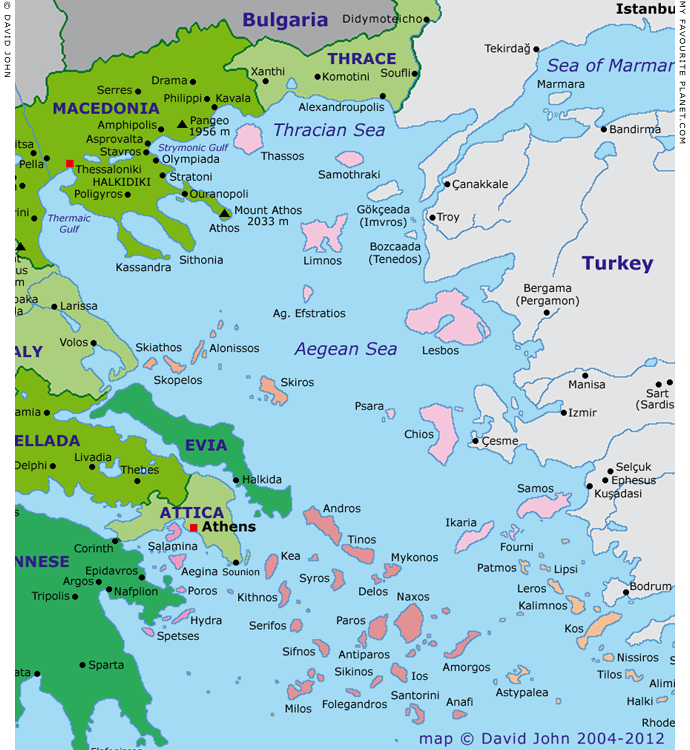
Interactive map of Macedonia, Thrace, Central Greece and the Aegean.
Colour key for Greek island groups (west-east)
| |
|
Argo-Saronic |
|
|
|
Sporades |
|
|
|
Cyclades |
|
|
|
Northern Aegean |
|
|
|
Dodecanese |
See also our interactive map of Greece. |
Photos, maps and articles: © David John,
except where otherwise specified.
All photos and articles are copyright protected.
Images and materials by other authors
have been attributed where applicable.
Please do not use these photos or articles without permission.
If you are interested in using any of the photos for your website,
project or publication, please get in contact.
Higher resolution versions are available on request.
My Favourite Planet makes great efforts to provide
comprehensive and accurate information across this website.
However, we can take no responsibility for inaccuracies or changes
made by providers of services mentioned on these pages. |
| |
 |
Visit the My Favourite Planet Group on Facebook.
Join the group, write a message or comment,
post photos and videos, start a discussion... |
|
|
| |
|
|
| |
| |
 |
| |
 |
| |
George Alvanos
rooms in
Kavala's historic Panagia District
Anthemiou 35,
Kavala, Greece
kavalarooms.gr
|
| |
 |
| |
 |
| |
 |
| |
 |
| |
Olive Garden Restaurant
Kastellorizo,
Greece
+30 22460 49 109
kastellorizo.de
|
| |
Papoutsis
Travel Agency
Kastellorizo,
Greece
+30 22460 49 286
greeklodgings.gr
|
| |
|